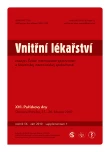Local intravenous fibrinolysis in children and adolescents
Authors:
I. Hofírek 1; M. Penka 2; M. Zvarová 3; S. Šárník 1; J. Blatný 2; O. Zapletal 2; J. Rotnágl 1
; O. Sochor 1
Authors‘ workplace:
I. interní kardio‑angiologická klinika Lékařské fakulty MU a FN u sv. Anny Brno, přednosta prof. MUDr. Jiří Vítovec, CSc., FESC
1; Oddělení klinické hematologie FN Brno, pracoviště Bohunice a pracoviště FDN J. G. Mendla, přednosta prof. MUDr. Miroslav Penka, CSc.
2; Oddělení klinické hematologie FN u sv. Anny Brno, přednostka prim. MUDr. Anna Zvarová
3
Published in:
Vnitř Lék 2010; 56(Supplementum 1): 58-63
Category:
16th Parizek's Days, Ostrava-Poruba, March 25th –26th 2010
Overview
The paper provides an evaluation of success factors and fibrinolytic dose regimes in adolescents and children whose deep vein thrombosis was managed with local ultrasound-enhanced fibrinolysis. It discusses factors determining success of fibrinolysis and reviews fibrinolytic dosing as well as plasma levels of the main monitored parameters (D-dimer and fibrinogen). The main risk factors associated with the development of deep vein thrombosis in a series of 15 cases included oral contraception use and the presence of genetic predisposition for thrombophilia. Success of thrombolysis did not depend on the duration of administration or a dose of a fibrinolytic agent but it was significantly more successful in individuals with shorter duration of thrombotic symptoms (anamnesis of approximately a week). Dosing of a fibrinolytic was better decided based on a trend in fibrinogen rather than D-dimer plasma levels. Together with fibrinolysis, continual IV low molecular weight heparin was routinely administered. Careful and supervised administration of a fibrinolytic decreases a risk of bleeding complications. Ultrasound-enhanced fibrinolysis alone is feasible in children and adolescents. The procedure is more successful in patients with short (approximately one week) history of symptoms.
Key words:
deep vein thrombosis – local fibrinolysis – duplex sonography
Sources
1. Michelson AD, Bovill E, Andrew M. Antithrombotic therapy in children. Chest 1995; 108 : 506S – 522S.
2. Vávrová M, Procházka V, Czerný D et al. May - Thurnerův syndrom v dětském věku. Ces Radiol 2007; 61 : 427 – 430.
3. van Hylckama Vlieg A, Helmerhorst FM, Vandenbroucke JP et al. The Venous Thrombotic Risk of Oral Contraceptives, Effects of Oestrogen Dose and Progestogen Type: Results of the MEGA Case - control Study. BMJ 2009; 339: b2921.
4. Karetová D. Flebotrombóza, tromboembolická nemoc. In: Karetová D, Staněk F et al. Angiologie pro praxi. Praha: Maxdorf 2007 : 210 – 250.
5. Carter CJ. The natural history and epidemiology of venous thrombosis. Prog Cardiovasc Dis 1994; 36 : 423 – 438.
6. Watson L, Armon MP. Thrombolysis for acute deep vein thrombosis. Cochrane Database of Systematic Reviews 2004, Issue 3. Art. No.: CD002783.
7. Snow V, Qaseem A, Barry P et al. Management of Venous Thromboembolism: A Clinical Practice Guideline from the American College of Physicians and the American Academy of Family Physicians. Ann Fam Med 2007; 5 : 74 – 80.
8. Roztočil K, Roček M. Léčba žilní trombózy. In: Widimský J, Malý J et al. Akutní plicní embolie a žilní trombóza. Praha: Triton 2005 : 277 – 288.
9. Hammer R, Harper DAT, Ryan PD. Paleontological Statistics Software Package for Education and Data Analysis. Palaeontologia Electronica 2001; 4 : 9.
10. Comerota AJ, Throm RC, Mathias SD et al. Catheter - directed thrombolysis for iliofemoral deep venous thrombosis improves health-related quality of life. J Vasc Surg 2000; 32 : 130 – 137.
11. Manco - Johnson MJ, Knapp - Clevenger R,Miller B et al. Post-thrombotic syndrome (PTS) in children: validation of a new pediatric outcome instrument and results in a comprehensive cohort of children with extremity deep vein thrombosis (DVT). Blood 2003; 102 : 553a.
12. Alesh I, Kayali F, Stein PD. Catheter - directed thrombolysis (intrathrombus injection) in treatment of deep venous thrombosis: a systematic review. Catheter Cardiovasc Interv 2007; 70 : 143 – 148.
13. Manco - Johnson MJ, Nuss R, Hays T et al. Combined thrombolytic and anticoagulant therapy for venous thrombosis in children. J Pediatr 2000; 136 : 446 – 453.
14. Wang M, Hays T, Balasa V et al. Low--dose tissue plasminogen activator thrombolysis in children. J Pediatr Hematol Oncol 2003; 25 : 379 – 386.
Labels
Diabetology Endocrinology Internal medicineArticle was published in
Internal Medicine

2010 Issue Supplementum 1
Most read in this issue
- Thrombocytopenia and coagulopathy in hepatopathy: an introduction into the issue
- Monitoring of coagulation parameters and options to influence them in patients with liver cirrhosis prior to invasive procedures
- Differential diagnosis of thrombocytopaenia in pregnancy
- The application of IPF (Immature platelet fraction) in laboratory diagnostics
